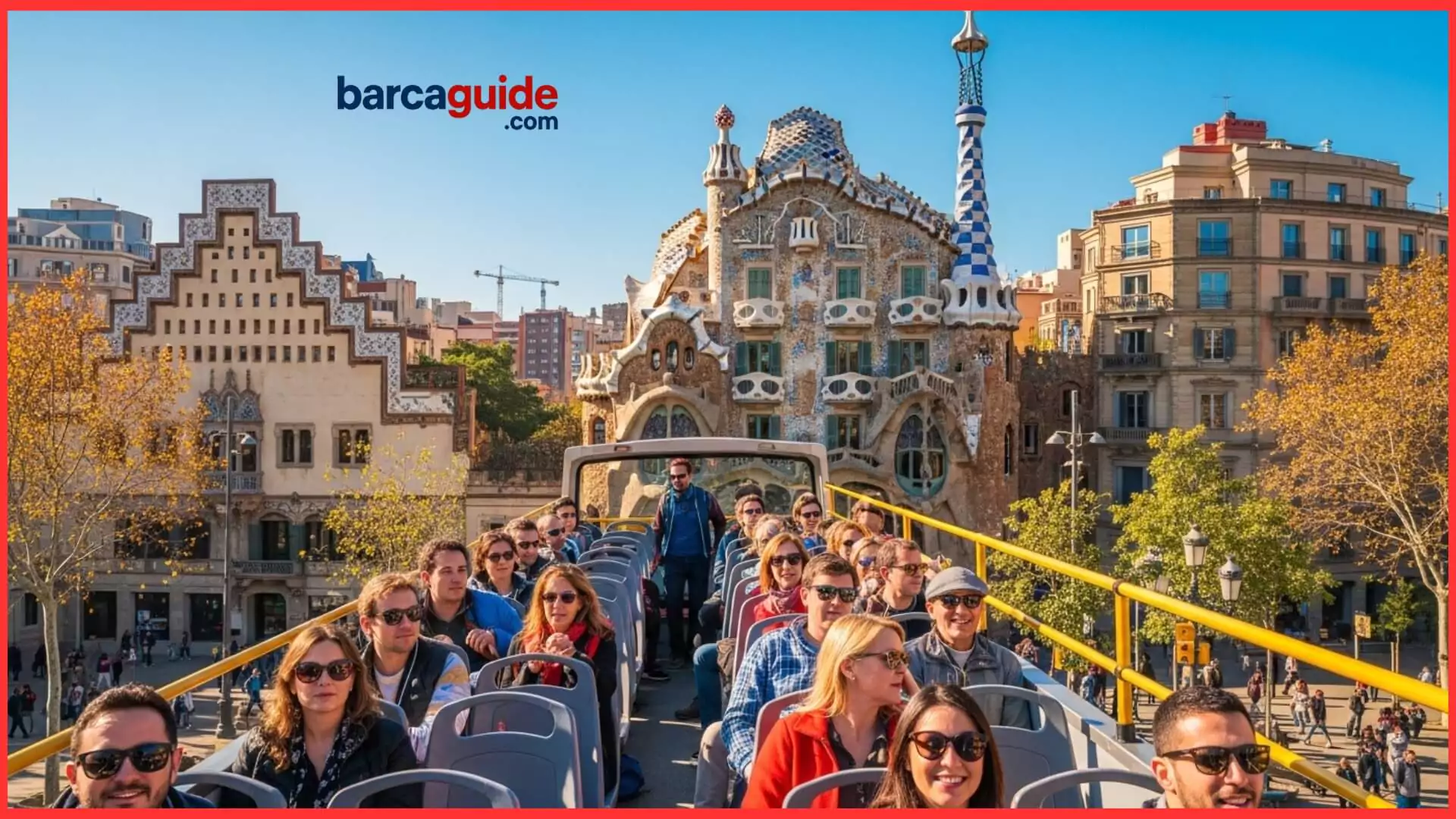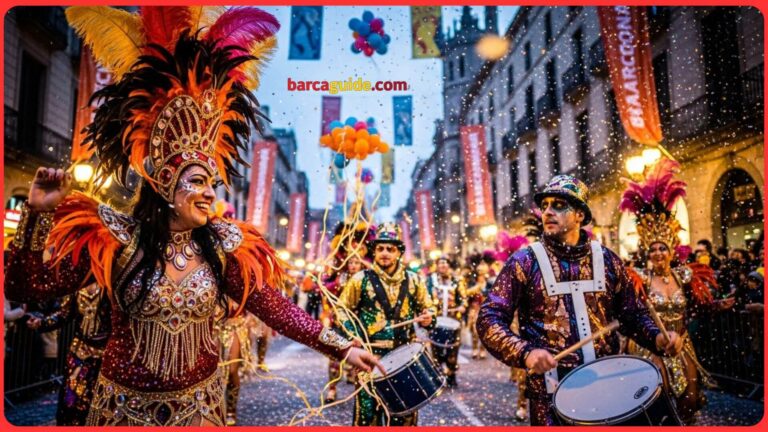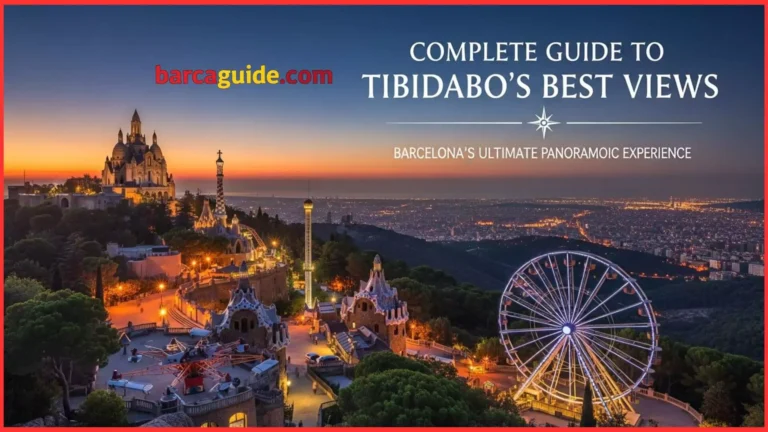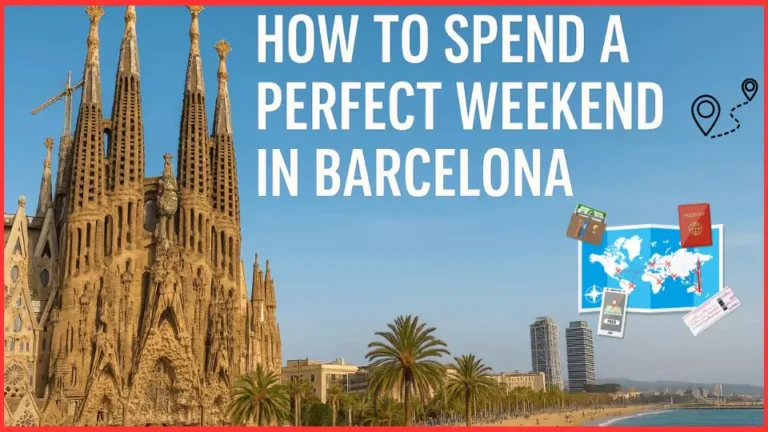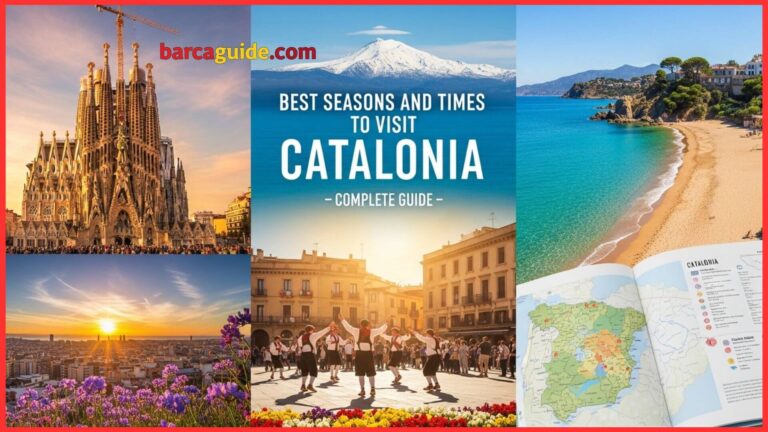Costa Brava to Barcelona: Explore Gaudí by Bus Tour
So You’re Thinking About a Day Trip to Barcelona?
you’re chilling on the gorgeous Costa Brava coastline, soaking up those beach vibes, when suddenly you realize – hey, Barcelona’s just right there! And I’m talking about one of Europe’s coolest cities, packed with the most mind-blowing architecture you’ll ever see. This bus tour thing? It’s honestly a no-brainer if you want to see Antoni Gaudí’s crazy-amazing buildings without dealing with all the hassle of figuring out Barcelona on your own.
Trust me, the bus ride itself is pretty sweet. You get to watch the scenery change from those dreamy Mediterranean views to the bustling city streets, and your guide’s chatting away about all sorts of interesting stuff. It’s like having a friend show you around, except this friend actually knows what they’re talking about!
Why Go with a Tour Instead of Winging It?
I get it – sometimes you just wanna do your own thing. But here’s the deal: Barcelona can be overwhelming if you don’t know where you’re going. Plus, have you tried parking in that city? Yeah, don’t. The guided tour takes care of all that annoying stuff so you can focus on the fun parts.
And here’s the kicker – you get to skip those crazy long lines at the big attractions. I’m talking about saving literally hours of your day that you’d otherwise spend standing around looking at other people’s backs. The guides also know all the secret photo spots and cool little details that you’d totally miss on your own. It’s like having a local best friend who happens to be obsessed with architecture.
Who the Heck Was Antoni Gaudí?
Alright, so Antoni Gaudí was this absolutely bonkers architect from the 1800s and early 1900s who basically said “screw straight lines” and created buildings that look like they came straight out of a fairy tale. The guy was born in 1852 in Catalonia, and honestly, I think he might’ve been from another planet because his imagination was just..
He was super religious and completely obsessed with nature, which explains why his buildings look more like giant flowers or underwater caves than actual buildings. The man literally studied trees and shells and said “yeah, I’m gonna make houses that look like this.” And somehow it worked!
Sadly, he got hit by a tram in 1926 (I know, random way to go), but not before he totally transformed Barcelona into this architectural wonderland that makes every other city look kinda boring in comparison.
How Gaudí Completely Changed Barcelona’s Look
Without Gaudí, Barcelona would just be another pretty European city. But with his crazy spires and wavy buildings everywhere, it’s like someone sprinkled magic dust all over the place. You can’t even imagine Barcelona without those iconic Sagrada Família towers poking up into the sky.
The coolest part? UNESCO looked at his stuff and was like “yep, this is so good it belongs to all humanity,” so now seven of his buildings are World Heritage Sites. Not bad for a guy who people probably thought was nuts when he was designing dragon-shaped houses!
What Made Him So Special?
Gaudí had this whole philosophy that went something like “God made nature, so if I copy nature, I’m basically channeling the divine.” Sounds a bit out there, but you can’t argue with the results. He’d spend hours studying how tree branches grow or how water flows, then somehow turn that into architectural genius.
His famous quote was “straight lines belong to men, curved lines belong to God,” which basically explains why none of his stuff looks like regular buildings. Everything flows and curves and seems alive somehow. Plus, he invented all these crazy engineering techniques that engineers today are still trying to figure out. The guy was basically the Einstein of architecture.
The Must-See Stops on Your Tour
The Sagrada Família – Prepare to Have Your Mind Blown
So the Sagrada Família isn’t just Gaudí’s masterpiece – it’s probably one of the most incredible buildings on the planet. And get this: they’re still building it! It’s been under construction for over 100 years, which is either really impressive or really slow, depending on how you look at it.
When you walk inside, it’s like stepping into an enchanted forest made of stone. The columns literally look like tree trunks branching up to the ceiling, and the light coming through those stained glass windows? Pure magic. The colors change throughout the day, so it’s like the building has moods. Your guide will explain all the religious symbolism, but honestly, even if you’re not religious, this place will give you chills.
Fun fact: they’re hoping to finish it by 2026, which would be the 100th anniversary of Gaudí’s death. No pressure, right?
Park Güell – It’s Like Candyland for Adults
If the Sagrada Família is Gaudí’s spiritual side, then Park Güell is where he let his inner child run wild. This place was supposed to be a fancy housing development for rich people, but when that didn’t work out, it became this amazing public park that’s basically like wandering through someone’s really good dream.
The entrance looks like something out of Hansel and Gretel, complete with gingerbread house vibes. And that famous dragon/salamander fountain? It’s probably the most Instagrammed thing in Barcelona (and for good reason – it’s adorable). The whole park is covered in this gorgeous broken tile mosaic work that sparkles in the sun.
The views from up there are insane too. You can see the whole city spread out below, and it’s one of those moments where you’re like “yep, this is why I travel.”
Casa Batlló and Casa Milà – When Houses Get Weird in the Best Way
These two buildings on Passeig de Gràcia are what happens when you give a genius architect complete creative freedom and wealthy clients who aren’t afraid to be different. Casa Batlló looks like it’s covered in dragon scales (which is actually the point – it’s supposed to represent the legend of Saint George and the dragon).
Casa Milà, which everyone calls “La Pedrera” (The Stone Quarry), looks like ocean waves frozen in stone. The rooftop is totally bonkers – the chimneys look like medieval knights having a party up there. Gaudí designed everything in these buildings, right down to the door handles and light switches. The man was seriously detail-obsessed, but in the best possible way.
What to Expect on Your Day Out
Getting There and Back
Most tours pick you up bright and early (we’re talking 8-9 AM) from the main Costa Brava spots like Lloret de Mar or Tossa de Mar. The buses are modern and comfy with AC, which you’ll definitely appreciate. The ride takes about 1.5 to 2 hours depending on where you’re starting from, but it goes by pretty fast with the guide chatting about what you’re gonna see.
During the drive, your guide basically becomes your personal Barcelona encyclopedia, filling you in on all the good stuff. It’s like a mini history lesson that actually doesn’t suck because you know you’re about to see all this cool stuff in person.
How Long You Get at Each Place
Here’s the deal with timing – you’ll get about 1.5 to 2 hours at the Sagrada Família, which sounds like a lot but trust me, you’ll want every minute. Park Güell gets about an hour to an hour and a half, which is perfect for seeing the highlights and getting those killer photos.
The house visits (Casa Batlló and Casa Milà) are a bit quicker – maybe 45 minutes to an hour each. It sounds rushed, but honestly, these places are pretty compact, and your guide knows exactly what to show you to make the most of your time.
Free Time to Explore Barcelona
Most tours give you about 1-2 hours of free time in the city center, usually around the Gothic Quarter or Las Ramblas. This is your chance to grab some tapas, do a little shopping, or just soak up the Barcelona vibe. Your guide will point you toward the good stuff – where to get the best coffee, which shops are worth checking out, that sort of thing.
Some people use this time for serious souvenir hunting, others just want to sit at a café and people-watch. Either way, it’s nice to have some unstructured time to do whatever feels right.
What You Get for Your Money
Your Guide – Your New Best Friend for the Day
The guides on these tours are usually locals who really know their stuff and genuinely love sharing their city with visitors. They’re not just reciting facts from a script – they’ll tell you stories about Gaudí’s quirky personality, point out details you’d never notice on your own, and give you the inside scoop on Barcelona life.
Plus, they speak multiple languages, so everyone in the group can follow along. And they’re usually pretty funny too, which makes the whole day more fun. A good guide can totally make or break a tour experience, and the Barcelona Gaudí tours generally have really solid guides.
The Comfort Factor
Look, wandering around a big city all day can be exhausting, but these tours take care of all the annoying logistics. The bus is comfortable, you don’t have to figure out public transport or worry about getting lost, and you get those precious skip-the-line tickets that save you from standing in tourist queues for hours.
The whole thing is just… easy. Which is exactly what you want when you’re on vacation.
How to Book This Thing
Booking Online – It’s Pretty Straightforward
Most tour companies have decent websites where you can book your spot and get instant confirmation. Just make sure you read the fine print about what’s included and what the cancellation policy is. Some companies are more flexible than others about changes and refunds.
Pro tip: book directly with the tour company rather than through third-party sites. You’ll usually get better customer service if something goes wrong, and sometimes the prices are even better.
When to Go for the Best Experience
Barcelona’s pretty awesome year-round, but spring and fall are definitely the sweet spots. The weather’s perfect, the crowds are more manageable, and you’ll get better photos without the harsh summer sun or winter gloom.
Summer can be crazy hot and crowded (we’re talking sardine-can levels at popular spots), while winter is cheaper and quieter but the weather’s more unpredictable. Pick your poison based on what matters most to you.
Stuff You Should Know Before You Go
What to Pack
Comfortable walking shoes are non-negotiable – you’ll be doing a lot of walking on all kinds of surfaces. Bring a small backpack for water, snacks, and all the random stuff you’ll accumulate during the day. Don’t forget sunscreen and a hat, especially if you’re going in summer.
And definitely bring a portable phone charger because you’re gonna take about a million photos and your battery will definitely die at the worst possible moment.
Dress Code Stuff
The Sagrada Família is still a working church, so they’re pretty strict about the dress code. Cover your shoulders and knees, and don’t wear anything see-through or super revealing. It’s not a big deal – just dress like you’re meeting someone’s grandma and you’ll be fine.
Layering is your friend because you’ll be going in and out of buildings all day, and Barcelona weather can be a bit unpredictable.
Why Art and Architecture Nerds Will Love This
It’s Not Just About Gaudí
While Gaudí is definitely the star of the show, he was part of this whole Catalan Modernism movement that was happening in Barcelona. The tour gives you context for understanding why all these wealthy Catalans were suddenly commissioning these wild architectural projects. It was like a whole cultural renaissance thing.
Understanding the technical side makes it even cooler. When your guide explains how Gaudí figured out these crazy structural innovations without computers, it’s pretty mind-blowing. The guy was solving engineering problems that architects today need specialized software to figure out.
The Spiritual Angle
Even if you’re not religious, there’s something pretty moving about Gaudí’s approach to architecture. He saw his buildings as prayers made of stone, and that spiritual dimension really comes through in his work. The Sagrada Família especially has this transcendent quality that affects people regardless of their beliefs.
His whole philosophy about learning from nature and channeling divine inspiration into his work creates buildings that feel alive somehow. It’s hard to explain, but you’ll know what I mean when you see it.
Tour vs. DIY – What’s the Better Call?
The Case for Tours
Tours are great for efficiency and learning. You’ll see more in one day than most people manage on their own, and you’ll actually understand what you’re looking at instead of just taking random photos. Plus, no stress about logistics, parking, or getting lost.
The social aspect is pretty fun too – you’ll meet other travelers who are into the same stuff, and sometimes those random tour bus conversations lead to lasting friendships.
Going Solo Has Its Perks
If you’re the type who likes to move at your own pace and dive deep into whatever catches your interest, then independent exploration might be more your speed. You can spend three hours at one place if you want, or skip stuff that doesn’t interest you.
But be realistic about what you can accomplish and how much planning you want to do. Barcelona’s a big city, and figuring out the optimal route between attractions can be pretty time-consuming.
What Works Best for Different Types of Travelers
Families with kids usually do better with tours because the guides know how to keep everyone engaged, and the structured schedule helps with planning around nap times and snack breaks. Solo travelers often love tours for the social aspect and the peace of mind.
If you’re a photography enthusiast who wants to wait for perfect lighting, or if you have very specific interests, you might be happier exploring independently.
The Bigger Picture – Tourism That Actually Helps
Supporting the Local Scene
When you choose locally-run tour companies, you’re directly supporting Barcelona’s economy and helping preserve local expertise. These local guides know their stuff because they live it every day, and their livelihoods depend on sharing authentic experiences with visitors.
Many tour companies also partner with local restaurants and shops, so your tourist dollars are spreading throughout the community rather than just going to big international corporations.
Keeping These Amazing Places Around
Your entrance fees and tour costs directly fund conservation efforts for these UNESCO World Heritage sites. The Sagrada Família’s ongoing construction is entirely funded by visitor contributions – no government money involved. So in a way, every tourist is helping finish Gaudí’s masterpiece.
It’s pretty cool when you think about it – responsible tourism can actually help preserve cultural treasures for future generations.
Other Cool Stuff You’ll See
The Gothic Quarter – Medieval Meets Modern
Most tours include a walk through Barcelona’s Gothic Quarter, which is like stepping back in time. These narrow medieval streets create this amazing contrast to Gaudí’s organic modernism. You’ve got 2,000-year-old Roman walls right next to trendy boutiques and cafés.
Walking through these ancient streets really helps you understand why Gaudí’s innovations were so revolutionary. The juxtaposition between old and new throughout Barcelona is pretty incredible.
Local Gems and Hidden Spots
Good guides love sharing their personal favorite spots – that little café where locals actually go, the hidden courtyard most tourists never see, the best place to get authentic churros. These insider tips often end up being the highlights of people’s trips.
These unexpected discoveries are what turn a good tour into a great travel memory. Plus, you’ll have recommendations for future visits or places to tell your friends about.
Practical Stuff – Languages and Accessibility
Language Options
Most professional tour operators offer guides who speak multiple languages – usually English, Spanish, French, German, and Italian. Some tours have separate groups for different languages, while others use guides who switch between languages throughout the day.
When you book, just double-check which languages will be available on your specific date. Some companies also provide written materials in additional languages to supplement the verbal commentary.
Accessibility Considerations
The tour buses are usually pretty accessible with wheelchair lifts and designated seating areas. But here’s the thing – Gaudí’s buildings are old and weren’t designed with modern accessibility standards in mind. There are lots of stairs, uneven surfaces, and narrow passages that can be challenging for people with mobility issues.
If you have specific accessibility needs, definitely talk to the tour operator before booking. They can give you detailed info about what’s accessible and what might be problematic. Some sites have alternative viewing areas or workarounds, but it’s better to know in advance.
What Other Travelers Are Saying
The Good Stuff People Rave About
Most people come back from these tours absolutely blown away by the Sagrada Família. Like, “I can’t believe this actually exists” levels of amazement. The guides consistently get praise for being knowledgeable and engaging, and people love not having to deal with logistics.
Photographers are always happy with the variety of shots they can get, and families often mention how well the guides connect with kids. The skip-the-line access gets mentioned in almost every positive review – nobody likes waiting in long tourist queues.
Common Complaints (And How to Avoid Them)
The most common gripe is about pacing – some people want more time at certain places. But honestly, this is just the nature of group tours. If you’re someone who needs to spend three hours at every stop, maybe consider going independently.
Weather-related changes sometimes disappoint people, but good operators handle these situations professionally. Most negative reviews seem to be from people who had unrealistic expectations rather than actual problems with the tour quality.
Pro Tips from Someone Who’s Been There
Photography Secrets
The lighting inside the Sagrada Família is absolutely magical in the late morning and early afternoon when those stained glass windows really pop. For Park Güell, try to avoid harsh midday sun – the mosaics look better in softer light.
Don’t try to get the whole building in every shot. Sometimes the coolest photos are the detail shots of Gaudí’s incredible decorative work. And pro tip: the crowds make wide shots tricky, so focus on angles that work with people in them rather than fighting it.
Beating the Crowds
Early morning tours are definitely less crowded, and weekdays are generally better than weekends. If you can swing a shoulder season visit (late fall through early spring), you’ll have a much more comfortable experience.
Within each site, listen to your guide’s advice about timing and positioning. They know exactly when and where the crowds will be thickest, so following their lead will save you from getting stuck in tourist bottlenecks.
Final Thoughts – Should You Do This?
Why This Tour Rocks
This tour is honestly one of those experiences that justifies your entire trip to Spain. You get to see some of the most incredible architecture in the world, learn fascinating stuff about art and culture, and do it all without the stress of planning and logistics. It’s educational, inspiring, and just plain fun.
Whether you’re into art, architecture, history, or you just like seeing cool stuff, Gaudí’s work will blow your mind. And the tour format means you’ll actually understand what you’re looking at instead of just wandering around confused.
For Costa Brava visitors, it’s the perfect way to add some cultural depth to your beach vacation. You get the best of both worlds – relaxing coastal vibes and world-class art and architecture.
FAQs
How long is the bus ride from Costa Brava to Barcelona?
It’s usually about 1.5 to 2 hours depending on where you’re starting from and traffic conditions. Lloret de Mar and Tossa de Mar are on the shorter side, while places like Girona might take a bit longer. The buses are comfortable and the time goes by pretty fast with the guide providing commentary.
Is lunch included in the tour?
Most tours don’t include lunch in the base price, which is actually good because it gives you flexibility to choose what and where you want to eat. You’ll get 1-2 hours of free time in Barcelona where you can grab tapas, hit a café, or try whatever looks good. Your guide will point you toward the good local spots.
Are the entrances to Gaudí sites included?
Usually yes for the big ones like Sagrada Família and Park Güell, since these require advance booking anyway. Casa Batlló and Casa Milà might be extra depending on the tour package. Always check what’s included when you book – some tours just do exterior viewing while others include full interior access.
Can I stay in Barcelona after the tour?
Most operators are cool with this, but definitely confirm when you book and let your guide know on the day. You’ll just need to figure out your own way back to Costa Brava later. It’s a great option if you want to experience Barcelona’s nightlife or explore more on your own.
Is the tour suitable for children?
Family-friendly tours work well for kids, though keep in mind it’s a long day (10-12 hours total with travel time) and involves a lot of walking. Most kids find Gaudí’s whimsical architecture pretty engaging, especially the colorful mosaics and fairy-tale elements. Guides usually adapt their commentary to keep younger audience members interested while still providing good info for adults.

